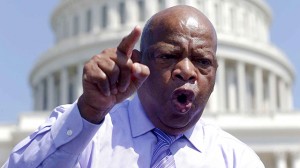This article originally appeared in The Nation.

Rep. John Lewis, D-Ga. speaks at a rally for immigration reform on Capitol Hill in Washington, Wednesday, April 10, 2013. (AP Photo/Charles Dharapak)
The Senate Judiciary Committee held its first hearing yesterday on the Voting Rights Act since the Supreme Court gutted the landmark civil rights law last month. The key witnesses were civil rights icon Representative John Lewis and Representative James Sensenbrenner, the former chair of the House Judiciary Committee who led the effort to overwhelmingly reauthorize the VRA in 2006.
In his testimony, Lewis described how he almost died fighting for the right to vote in 1965 and how friends of his never made it out of Mississippi alive. “I remember these problems and this struggle like it was yesterday,” Lewis said. He noted the “deliberate and systematic” attempt to make it harder for voters to participate in the last election, when nineteen states passed twenty-five new voting restrictions, saying “the Voting Rights Act is needed now like never before.”
His colleague Representative Sensenbrenner called the VRA the most important civil rights law of the twentieth century and said, “We cannot afford to lose it now.” The court’s decision presents Congress with a “historic opportunity” to draft a revised Section 4 of the VRA, he said, covering jurisdictions with “recent and egregious voting records.” Sensenbrenner mentioned that he proudly displays the pen Ronald Reagan used to sign the 1982 reauthorization of the VRA. “Though the Voting Rights Act has been enormously successful, we know our work is not complete,” he said. The key will be whether Sensenbrenner can bring fellow House Republicans along with him, like he did in 2006. “I’m certainly on board to put something together that will last for a long time,” he said.
Today, the House Judiciary Committee Subcommittee on the Constitution will hold its first hearing on the VRA, which will give a good indication of where House Republicans stand on the issue. The subcommittee chairman, Representative Trent Franks of Arizona, was one of only thirty-three House Republicans to vote against the VRA’s reauthorization in 2006.
Beyond Sensenbrenner, there wasn’t much enthusiasm among Republicans on the Senate Judiciary Committee to revise the VRA. Only two Republicans attended the hearing, Senators Grassley and Cruz, neither of whom stayed the full time. Cruz praised the Supreme Court’s decision, while Grassley and witness Michael Carvin, a prominent Republican lawyer at Jones Day, suggested that Section 2 would be an adequate replacement for Sections 4 & 5. (Section 4 determines how states are covered under Section 5, which requires that states with the worst history of voting discrimination clear their voting changes with the federal government.)
Luz Urbáez Weinberg, a Republican city commissioner in Aventura, Florida, in Miami-Dade County, strongly disagreed with that argument. “Section 5 has no peer,” she said. “Section 2 is not sufficient.” Section 5 puts the burden of proof on targeted jurisdictions to show that their voting changes are not discriminatory before they go into effect, whereas Section 2 forces plaintiffs to show that a voting change is discriminatory, usually only after it has gone into effect, following lengthy, expensive litigation. It’s the difference between stopping a crime before it exists versus forcing the victim of the crime to seek justice afterward.
Not only is Section 5 far more effective than Section 2, it has accurately targeted those places with the worst history of voting discrimination. According to voting rights historian Morgan Kousser, “From 1957 through 2006, almost 94 percent of all voting rights minority lawsuits, legal objections and out-of-court settlements occurred in jurisdictions now subject to federal oversight under the Section 4 formula.”
So what can Congress do now? It can draft a revised Section 4 based on more current data. It can make it easier to “bail-in” states with recent voting violations under Section 3 (which MSNBC’s Adam Serwer called a “secret weapon”) and make it easier for voting rights groups and the DOJ to win Section 2 cases.
It was obvious from the hearing that Congress will not come to a consensus unless it faces a tremendous amount of pressure to do so. Voting rights supporters, as I wrote recently, have a four-pronged strategy for responding to the Court’s decision:
Challenge new voting restrictions through preliminary injunctions and Section 2 of the VRA (which applies nationwide, but puts the onus on plaintiffs to prove that a law is discriminatory after enactment); pressure Congress to reconstruct the VRA; draft a new coverage formula for Section 4; and mobilize indignant voters to make their voices heard, starting with the fiftieth anniversary of the March on Washington on August 28.
The need for Congress to act is clear. The Justice Department blocked 1,116 discriminatory voting changes from taking effect under Section 5 from 1965 to 2004 and objected to thirty-seven electoral proposals after Congress reauthorized the law in 2006. Immediately following the decision, five Southern states rushed to implement new voter-ID laws that disproportionately affect young and minority voters. A sixth covered state, North Carolina, is on the verge of passing a new voter ID law by the end of this week. According to the state’s own numbers, 316,000 registered voters don’t have state-issued ID; 34 percent are African American and 55 percent are registered Democrats. Of the 138,000 voters without ID who cast a ballot in the 2012 election, 36 percent were African American and 59 registered percent Democrats. The new draft of the bill does not allow student IDs for voting and would cost $10 to obtain unless a voter signs a form saying they cannot afford the ID under penalty of perjury, making it among the most restrictive laws in the country. A number of other harsh voting restrictions—such as cutting early voting, ending same-day voter registration and penalizing the parents of students who vote where they go to school—could be added to the bill. (It’s worth noting that voter fraud in the state, which the legislation purports to stop, is incredibly rare; there were only two prosecutions of voter impersonation between 2000 and 2010.)
Simply looking at what’s happened since the Court’s decision—not to mention the four overwhelming reauthorizations of the VRA in 1970, 1975, 1982 and 2006—should give Congress ample evidence on which to act.
[UPDATE, July 18, 1:20 pm]:
The House Judiciary Committee just concluded its first hearing on the VRA, where it was clear that no consensus exists between the parties on whether to fix the VRA or how to do so. The Republican congressmen and witnesses maintained that existing parts of the VRA, notably Sections 2 and 3, were sufficient replacements for Sections 4 and 5 and thus, in the words of Hans von Spakovsky of the Heritage Foundation: “there’s no reason for Congress to take any action.”
Rep. Goodlatte (R-VA), chairman of the Judiciary Committee, said that even though Section 4 has been ruled unconstitutional, thereby paralyzing Section 5, “other very important provisions remain in place.” Added Christian Adams, a former Bush Administration official in the DOJ civil rights division who pushed the bogus lawsuit against the New Black Panther Party in Philadelphia: “Reports of the demise of the Voting Rights Act have been greatly exaggerated. What remains? Everything else.” Von Spakovsky called Section 2 “the heart of the VRA.”
It’s worth expanding on how disingenuous these claims are. As I noted above, neither Section 2 nor Section 3 come close to having the impact of Section 5. As election law expert Rick Hasen writes: “Section 2 is no substitute for Section 5. It has virtually no teeth these days outside of the redistricting area…It has not been used successfully go to after voter ID, and it would be hard to use it (given the statutory standard) to go after problems with voter registration and long lines. Even worse, if courts start reading Section 2 more broadly to cover things like voter ID, then Section 2 itself could be found by the Roberts Court to be unconstitutional.” As Justice Kennedy said in 2009 (and seems to have forgotten in 2013), “Section 2 cases are very expensive. They are very long. They are very inefficient.” That’s why DOJ – which blocked discriminatory voting laws in places like Texas during the last election under Section 5 – hasn’t filed a single Section 2 lawsuit during the Obama administration.
Moreover, states with recent voting violations can only be covered under Section 3 of the VRA if plaintiffs show that voting changes were enacted with intentional discrimination, which is almost impossible to prove. Congress could amend Section 3 so that plaintiffs only have to prove the effect of discrimination to win a case, but absent that, Section 3 will remain a little-used remedy.
Section 5 is so important because, as Bob Kengle of the Lawyers’ Committee for Civil Rights noted, “racial discrimination in voting needs to be stopped before it occurs.” Spencer Overton of George Washington University Law School likened it to the metal detector he passed through before testifying today in the House.
Rep. Sensenbrenner is still the only high-profile Republicans to argue that Section 5 remains vital. The rest of the GOP seems to be reciting talking points from the Heritage Foundation. Unless a tremendous amount of pressure is brought upon Congress to resurrect Section 4 or to strengthen the other parts of the VRA – starting during the August recess – chances for VRA reform look pretty slim.
| Ari Berman is a contributing writer for The Nation magazine and an investigative journalism fellow at The Nation Institute. His first book, Herding Donkeys: The Fight to Rebuild the Democratic Party and Reshape American Politics, was published in October 2010 by Farrar, Straus, and Giroux. He is now working on a history of voting rights since 1965. |  |

